Comprehensive Transcriptomic Analysis of Heterotrophic Nitrifying Bacterium Klebsiella sp. TN-10 in Response to Nitrogen Stress
Abstract
:1. Introduction
2. Materials and Methods
2.1. Culture Condition and Ammonia Nitrogen Stress of Bacterial Strain
2.2. DNA Extraction and Genome Sequencing
2.3. RNA Extraction
2.4. Library Construction and Illumina Deep Sequencing
2.5. RNA-Sequencing, de Novo Transcriptome Assembly
2.6. Differentially Expressed Gene Analysis and Functional Enrichment
2.7. Validation of the RNA-Sequencing Data by Quantitative RT-PCR
3. Results and Discussion
3.1. Effects of Initial Ammonia Nitrogen Concentration on the Growth and Ammonia Nitrogen Removal of Klebsiella sp. TN-10
3.2. General Genome Information of Strain TN-10
3.3. De-Novo Assembly and DEGs Analysis
3.4. Enrichment Analysis of DEGs
3.5. Function Enrichment of DEGs
3.6. Effect of Ammonia Nitrogen Stress on the Main Pathway of Energy Supply
3.7. Effect of Ammonia Nitrogen Stress on Amino Acid Metabolism
3.8. Effect of Ammonia Nitrogen Stress on the Nitrogen Cycle Pathway
3.9. q-PCR
4. Conclusions
Supplementary Materials
Author Contributions
Funding
Institutional Review Board Statement
Informed Consent Statement
Data Availability Statement
Conflicts of Interest
References
- He, T.; Xie, D.; Li, Z.; Ni, J.; Sun, Q. Ammonium stimulates nitrate reduction during simultaneous nitrification and denitrification process by Arthrobacter arilaitensis Y-10. Bioresour. Technol. 2017, 239, 66–73. [Google Scholar] [CrossRef] [PubMed]
- Feng, C.; Huang, L.; Yu, H.; Yi, X.; Wei, C. Simultaneous phenol removal, nitrification and denitrification using microbial fuel cell technology. Water Res. 2015, 76, 160–170. [Google Scholar] [CrossRef] [PubMed]
- Wang, Z.; Zhang, X.X.; Lu, X.; Liu, B.; Li, Y.; Long, C.; Li, A. Abundance and diversity of bacterial nitrifiers and denitrifiers and their functional genes in tannery wastewater treatment plants revealed by high-throughput sequencing. PLoS ONE 2014, 9, e113603. [Google Scholar] [CrossRef] [PubMed]
- Raman, C.D.; Kanmani, S. Textile dye degradation using nano zero valent iron: A review. J. Environ. Manag. 2016, 177, 341–355. [Google Scholar] [CrossRef]
- Ren, Y.X.; Yang, L.; Liang, X. The characteristics of a novel heterotrophic nitrifying and aerobic denitrifying bacterium, Acinetobacter junii YB. Bioresour. Technol. 2014, 171, 1–9. [Google Scholar] [CrossRef]
- Yang, X.-P.; Wang, S.-M.; Zhang, D.-W.; Zhou, L.-X. Isolation and nitrogen removal characteristics of an aerobic heterotrophic nitrifying–denitrifying bacterium, Bacillus subtilis A1. Bioresour. Technol. 2011, 102, 854–862. [Google Scholar] [CrossRef]
- Taylor, S.M.; Yiliang, H.; Bin, Z.; Jue, H. Heterotrophic ammonium removal characteristics of an aerobic heterotrophic nitrifying-denitrifying bacterium, Providencia rettgeri YL. J. Environ. Sci. 2009, 21, 1336–1341. [Google Scholar] [CrossRef]
- Zhao, B.; He, Y.L.; Zhang, X.F. Nitrogen removal capability through simultaneous heterotrophic nitrification and aerobic denitrification by Bacillus sp. LY. Environ. Technol. 2010, 31, 409–416. [Google Scholar] [CrossRef]
- Third, K.A.; Gibbs, B.; Newland, M.; Cordruwisch, R. Long-term aeration management for improved N-removal via SND in a sequencing batch reactor. Water Res. 2005, 39, 3523–3530. [Google Scholar] [CrossRef]
- Padhi, S.K.; Tripathy, S.; Sen, R.; Mahapatra, A.S.; Mohanty, S.; Maiti, N.K. Characterisation of heterotrophic nitrifying and aerobic denitrifying Klebsiella pneumoniae CF-S9 strain for bioremediation of wastewater. Int. Biodeterior. Biodegrad. 2013, 78, 67–73. [Google Scholar] [CrossRef]
- Murugapiran, S.K.; Huntemann, M.; Wei, C.-L.; Han, J.; Detter, J.C.; Han, C.S.; Erkkila, T.H.; Teshima, H.; Chen, A.; Kyrpides, N. Whole genome sequencing of Thermus oshimai JL-2 and Thermus thermophilus JL-18, incomplete denitrifiers from the United States Great Basin. Genome Announc. 2013, 1, e00106–e00112. [Google Scholar] [CrossRef] [PubMed] [Green Version]
- Kukurba, K.R.; Montgomery, S.B. RNA sequencing and analysis. Cold Spring Harbor Protoc. 2015, 2015, 940–951. [Google Scholar] [CrossRef] [Green Version]
- Sayavedrasoto, L.; Ferrell, R.; Dobie, M.; Mellbye, B.; Chaplen, F.; Buchanan, A.; Chang, J.; Bottomley, P.; Arp, D. Nitrobacter winogradskyi transcriptomic response to low and high ammonium concentrations. FEMS Microbiol. Lett. 2014, 362, 1–7. [Google Scholar] [CrossRef] [PubMed] [Green Version]
- Li, B.; Lv, R.; Xiao, Y.; Hu, W.; Mai, Y.; Zhang, J.; Lin, L.; Hu, X. A novel nitrite-base aerobic denitrifying bacterium Acinetobacter sp. YT03 and its transcriptome analysis. Front. Microbiol. 2019, 10, 1–13. [Google Scholar] [CrossRef] [PubMed]
- Cole, T.; Williams, B.A.; Geo, P.; Ali, M.; Gordon, K.; Baren, M.J.; Van Salzberg, S.L.; Wold, B.J.; Lior, P. Transcript assembly and quantification by RNA-Seq reveals unannotated transcripts and isoform switching during cell differentiation. Nat. Biotechnol. 2010, 28, 511–515. [Google Scholar]
- Tang, P.A.; Wu, H.-J.; Xue, H.; Ju, X.-R.; Song, W.; Zhang, Q.-L.; Yuan, M.-L. Characterization of transcriptome in the Indian meal moth Plodia interpunctella (Lepidoptera: Pyralidae) and gene expression analysis during developmental stages. Gene 2017, 622, 29–41. [Google Scholar] [CrossRef] [PubMed]
- Hervás, A.B.; Canosa, I.; Santero, E. Transcriptome analysis of Pseudomonas putida in response to nitrogen availability. J. Bacteriol. 2008, 190, 416–420. [Google Scholar] [CrossRef] [Green Version]
- Liu, H.; Luo, Y.; Han, J.; Wu, J.; Wu, Z.; Feng, D.; Cai, S.; Li, M.; Liu, J.; Zhou, J. Proteome reference map of Haloarcula hispanica and comparative proteomic and transcriptomic analysis of polyhydroxyalkanoate biosynthesis under genetic and environmental perturbations. J. Proteome Res. 2013, 12, 1300–1315. [Google Scholar] [CrossRef]
- Lu, H.; Ulanov, A.V.; Nobu, M.; Liu, W.-T. Global metabolomic responses of Nitrosomonas europaea19718 to cold stress and altered ammonia feeding patterns. Appl. Microbiol. Biotechnol. 2016, 100, 1843–1852. [Google Scholar] [CrossRef]
- Zhang, S.; Zeng, X.; Ren, M.; Mao, X.; Qiao, S. Novel metabolic and physiological functions of branched chain amino acids: A review. J. Anim. Sci. Biotechnol. 2017, 8, 501–512. [Google Scholar] [CrossRef] [Green Version]
- Doi, M.; Yamaoka, I.; Fukunaga, T.; Nakayama, M. Isoleucine, a potent plasma glucose-lowering amino acid, stimulates glucose uptake in C2C12 myotubes. Biochem. Biophys. Res. Commun. 2003, 312, 1111–1117. [Google Scholar] [CrossRef] [PubMed]
- Teodoro, G.F.R.; Vianna, D.; Torres-Leal, F.L.; Pantaleao, L.C.; Matos-Neto, E.M.; Donato, J., Jr.; Tirapegui, J. Leucine is essential for attenuating fetal growth restriction caused by a protein-restricted diet in rats. J. Nutr. 2012, 142, 924–930. [Google Scholar] [CrossRef] [PubMed] [Green Version]
- Castrejón, V.; Parra, C.; Moreno, R.; Pena, A.; Uribe, S. Potassium collapses the ΔPin yeast mitochondria while the rate of ATP synthesis is inhibited only partially: Modulation by phosphate. Arch. Biochem. Biophys. 1997, 346, 37–44. [Google Scholar] [CrossRef]
- Caldovic, L.; Tuchman, M. N-acetylglutamate and its changing role through evolution. Biochem. J. 2003, 372, 279–290. [Google Scholar] [CrossRef]
- Cooper, J.T.; Sinclair, G.A.; Wawrik, B. Transcriptome analysis of Scrippsiella trochoidea CCMP 3099 reveals physiological changes related to nitrate depletion. Front. Microbiol. 2016, 7, 1–19. [Google Scholar] [CrossRef] [PubMed] [Green Version]
- Goswami, G.; Panda, D.; Samanta, R.; Boro, R.C.; Modi, M.K.; Bujarbaruah, K.M.; Barooah, M. Bacillus megaterium adapts to acid stress condition through a network of genes: Insight from a genome-wide transcriptome analysis. Sci. Rep. 2018, 8, 1–12. [Google Scholar] [CrossRef] [Green Version]
- Goberdhan, D.C.; Wilson, C.; Harris, A.L. Amino acid sensing by mTORC1, intracellular transporters mark the spot. Cell Metab. 2016, 23, 580–589. [Google Scholar] [CrossRef] [Green Version]
- Mehta, S.; Gaur, J. Heavy-metal-induced proline accumulation and its role in ameliorating metal toxicity in Chlorella vulgaris. New Phytol. 1999, 143, 253–259. [Google Scholar] [CrossRef]
- He, X.-S.; Xi, B.-D.; Jiang, Y.-H.; He, L.-S.; Li, D.; Pan, H.-W.; Bai, S.-G. Structural transformation study of water-extractable organic matter during the industrial composting of cattle manure. Microchem. J. 2013, 106, 160–166. [Google Scholar] [CrossRef]
- Burkovski, A. Nitrogen control in Corynebacterium glutamicum: Proteins, mechanisms, signals. J. Microbiol. Biotechnol. 2007, 17, 187–194. [Google Scholar]
- Gregory, L.G.; Bond, P.L.; Richardson, D.J.; Stephen, S. Characterization of a nitrate-respiring bacterial community using the nitrate reductase gene (narG) as a functional marker. Microbiology 2003, 149, 229–237. [Google Scholar] [CrossRef] [PubMed] [Green Version]
- Pao, S.S.; Paulsen, I.T.; Saier, M.H. Major facilitator superfamily. Microbiol. Mol. Biol. Rev. 1998, 62, 1–34. [Google Scholar] [CrossRef] [PubMed] [Green Version]
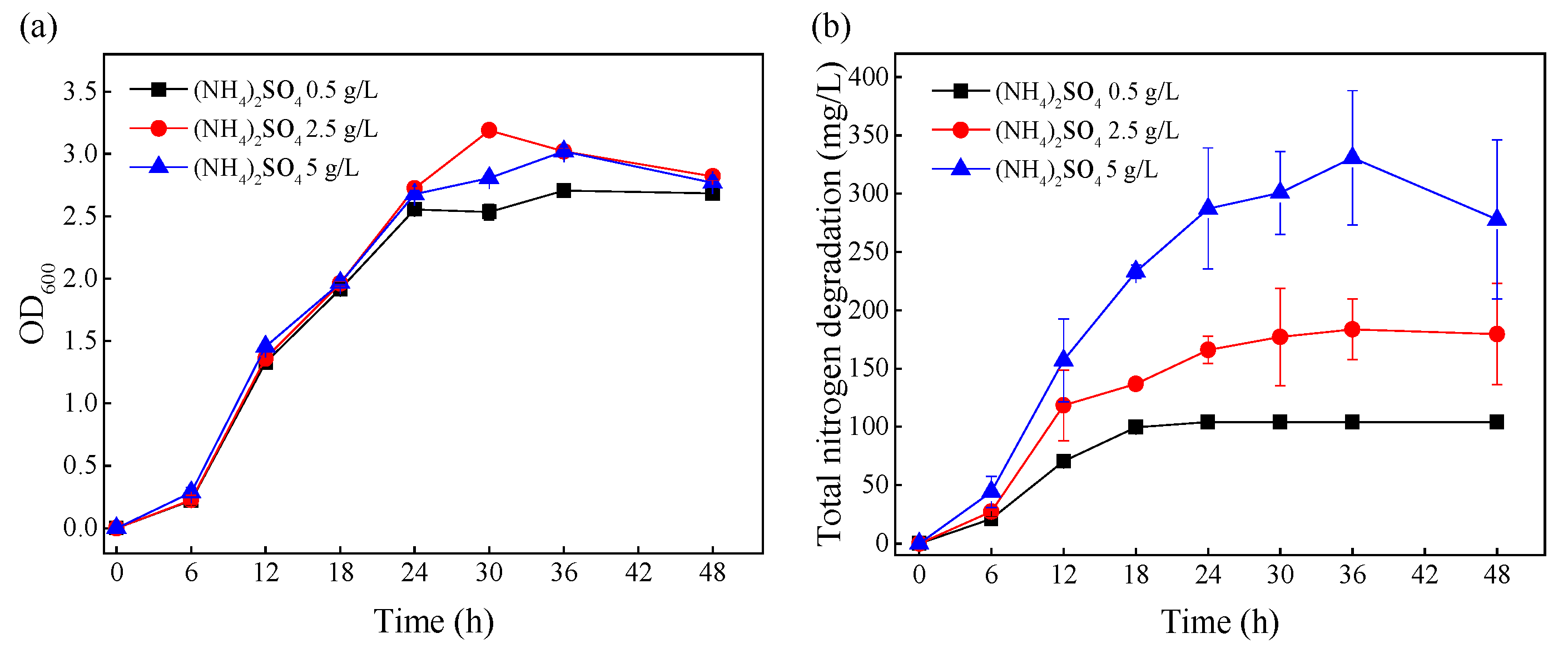
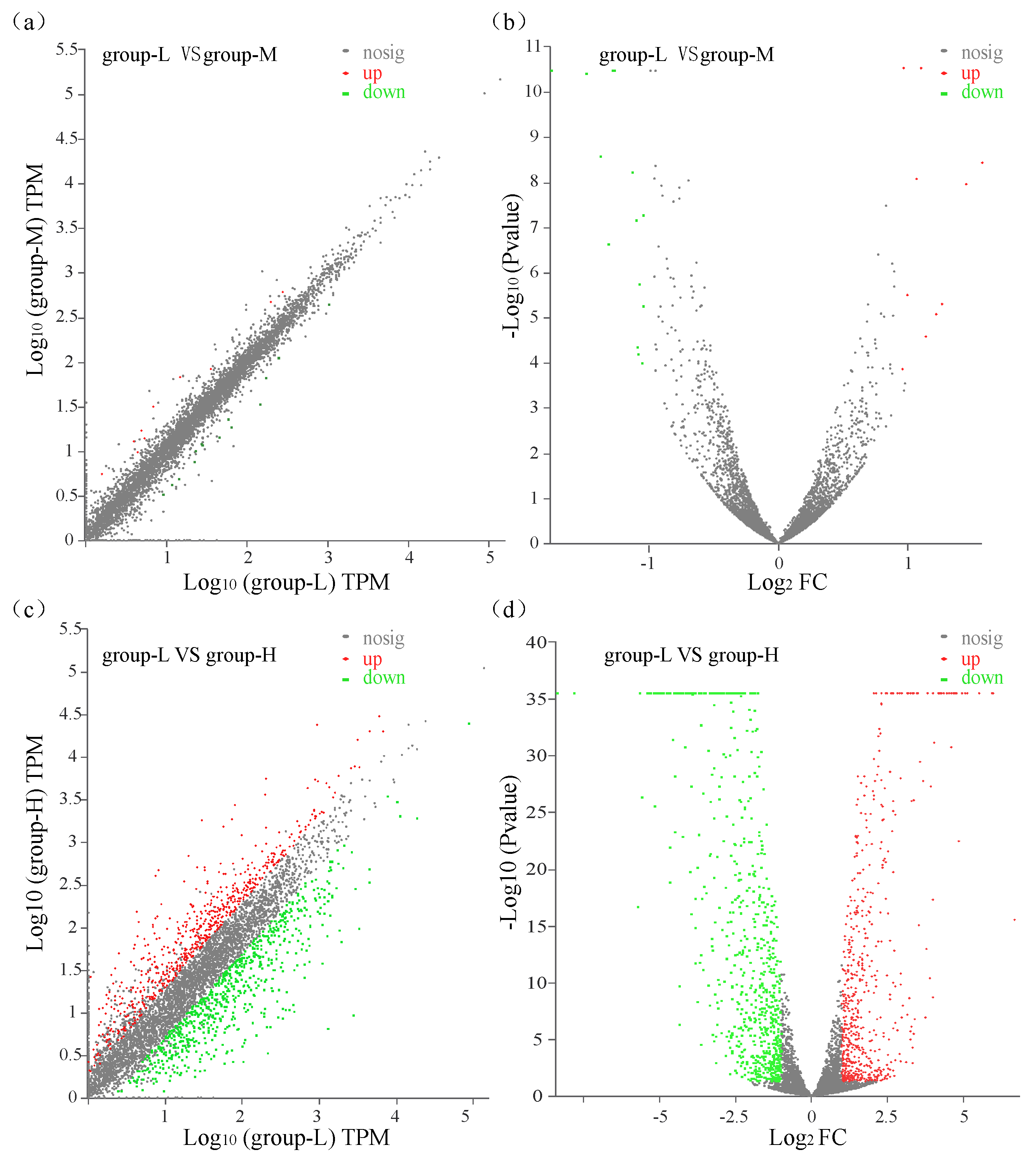
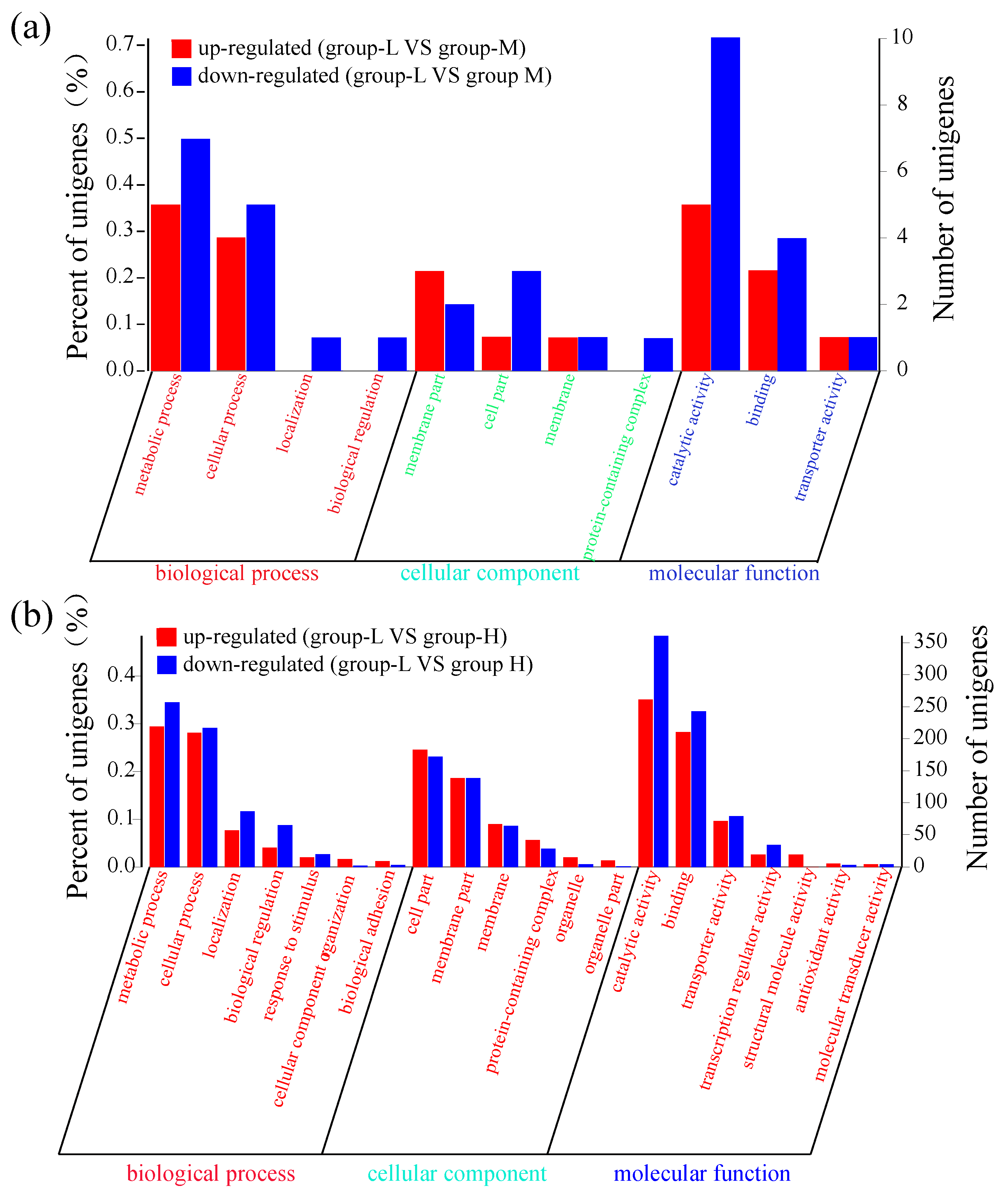
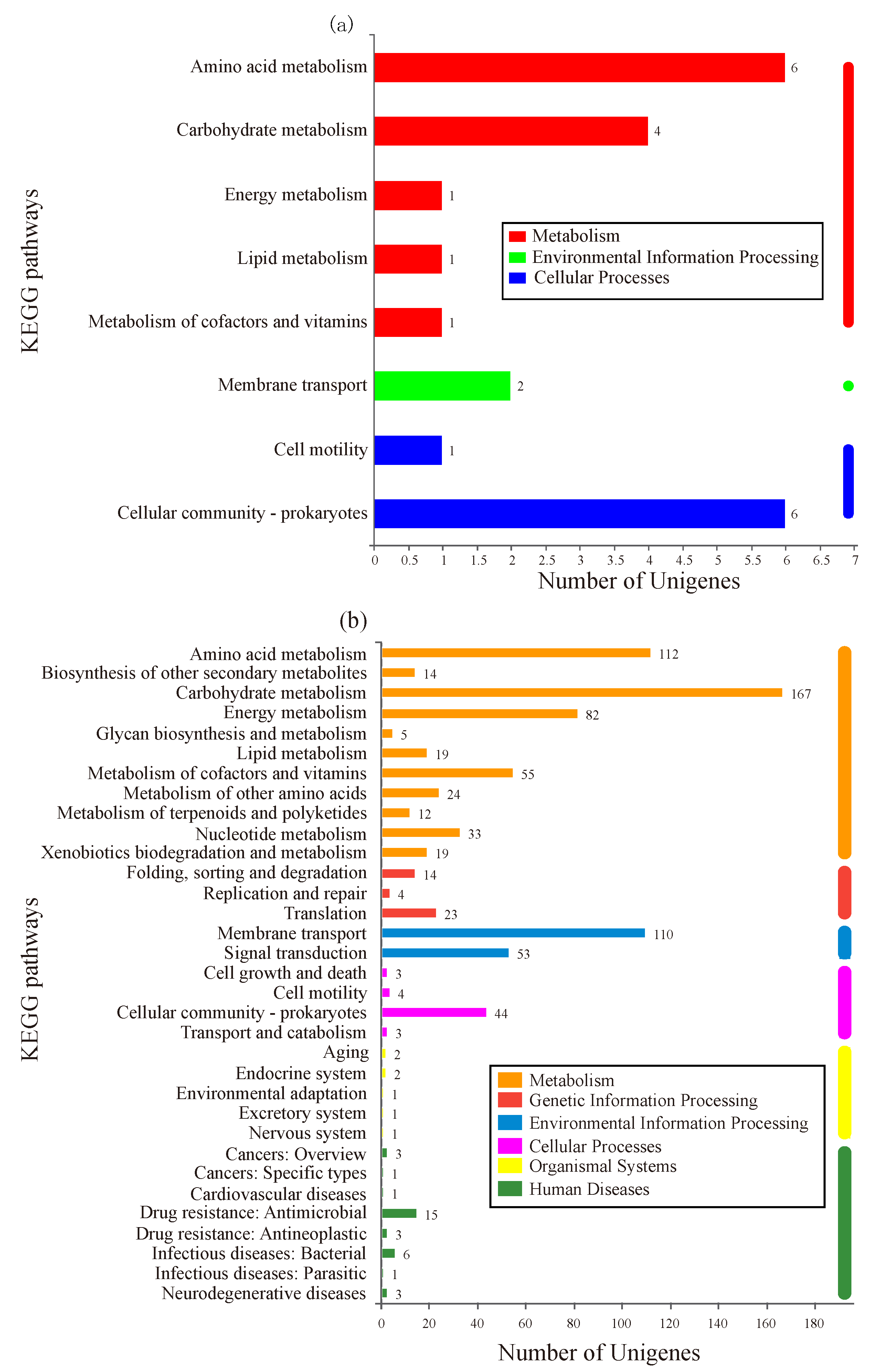


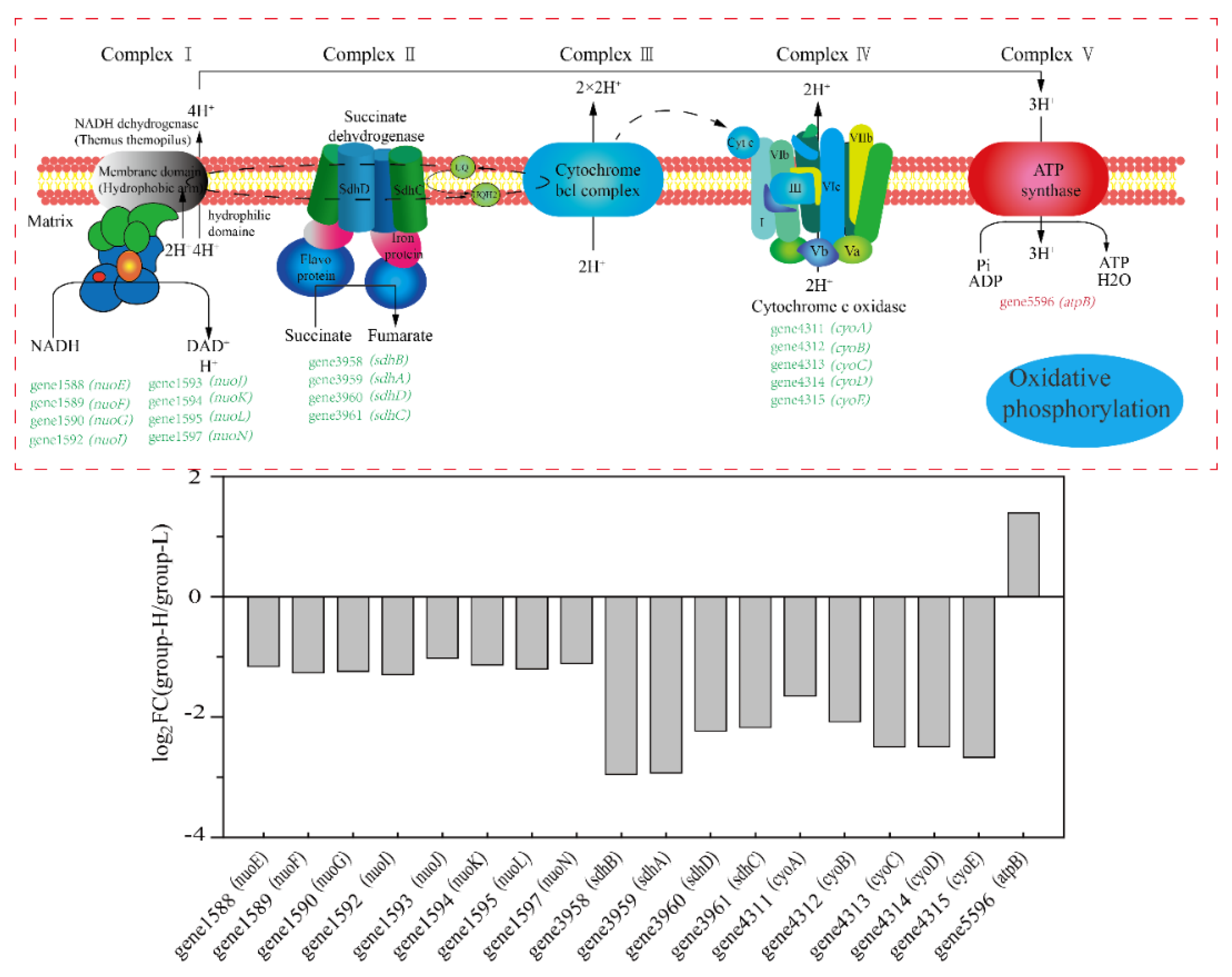


Publisher’s Note: MDPI stays neutral with regard to jurisdictional claims in published maps and institutional affiliations. |
© 2022 by the authors. Licensee MDPI, Basel, Switzerland. This article is an open access article distributed under the terms and conditions of the Creative Commons Attribution (CC BY) license (https://creativecommons.org/licenses/by/4.0/).
Share and Cite
Li, D.; Huang, M.; Dong, S.; Jin, Y.; Zhou, R.; Wu, C. Comprehensive Transcriptomic Analysis of Heterotrophic Nitrifying Bacterium Klebsiella sp. TN-10 in Response to Nitrogen Stress. Microorganisms 2022, 10, 353. https://doi.org/10.3390/microorganisms10020353
Li D, Huang M, Dong S, Jin Y, Zhou R, Wu C. Comprehensive Transcriptomic Analysis of Heterotrophic Nitrifying Bacterium Klebsiella sp. TN-10 in Response to Nitrogen Stress. Microorganisms. 2022; 10(2):353. https://doi.org/10.3390/microorganisms10020353
Chicago/Turabian StyleLi, Dan, Mingquan Huang, Shirong Dong, Yao Jin, Rongqing Zhou, and Chongde Wu. 2022. "Comprehensive Transcriptomic Analysis of Heterotrophic Nitrifying Bacterium Klebsiella sp. TN-10 in Response to Nitrogen Stress" Microorganisms 10, no. 2: 353. https://doi.org/10.3390/microorganisms10020353





